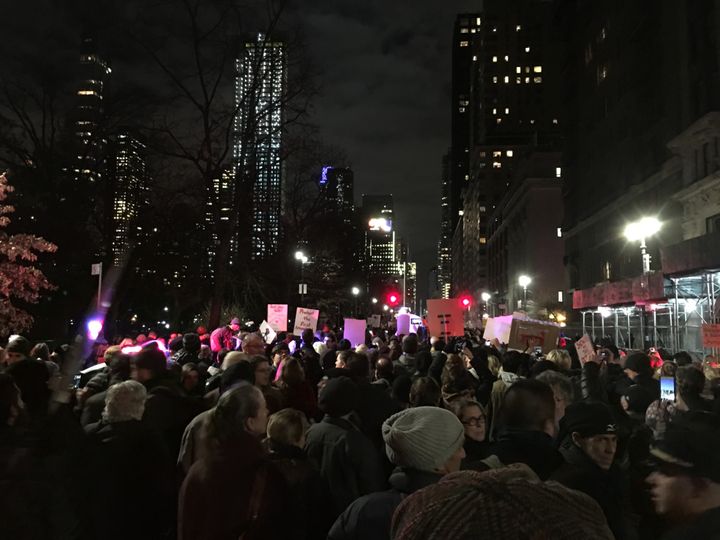
Standing in with the resistance on Central Park West on Inauguration Eve
Donald Trump's coronation got you down? As a follow up to my previous post, I'd like to recommend four orchestral pieces to help you work through your feelings, strengthen your resolve, and inspire you to action. Listen to one, or to all four, and be grateful that music will endure whatever idiocy America's dysfunctional political system can throw at us.
Stage 1: Rage - Shostakovich Symphony No. 4
Throughout his life, composer Dmitry Shostakovich played a game of cat and mouse with the Soviet dictator Joseph Stalin and his henchmen. Shostakovich was the mouse. Following the premiere of his opera in 1936, the Soviet news agency Pravda condemned the work harshly in an editorial entitled "Chaos Instead of Music." Soviet music was supposed to realistically portray the country's enlightened social ambitions, and citing Shostakovich's work for "formalism" meant rejecting it for embracing Western "decadence." Shostakovich soldiered on and completed his Fourth Symphony, but under pressure from the authorities, he withdrew it at the last minute (it wasn't premiered until 1961, eight years after Stalin's death). Listening now, we understand why Shostakovich was right to be afraid of the reaction. One observer called it a "volcanic explosion," a reference to the work's massive size, deafening climaxes, emotional extremes, and fiercely defiant tone. As the work fades away more than an hour later, the listener senses that the protagonist of the symphony has just barely survived a harrowing and sure-to-be-recurring nightmare.
Stage 2: Defiance - Beethoven Symphony No. 3, "Eroica"
Inspired by the ideals of the Enlightenment, and the political forces set in motion by the French Revolution, Beethoven originally intended his Third Symphony as a tribute to Napoleon Bonaparte, the man who seemed to most embody the new spirit of the age. However, when the French leader crowned himself Emperor, Beethoven angrily scratched out the dedication and wrote Sinfonia eroica, composta per festeggiare il sovvenire d'un grand'uomo (heroic symphony, composed to celebrate the memory of a great man). The second movement, a powerful funeral march, conveys the composer's disappointment for a failed dream. Though he continued living in Vienna, a city that was under siege and then occupied by French troops, Beethoven remained unbowed, and throughout his life continued to espouse the ideal of universal brotherhood, reaching its culmination in the famous "Ode to Joy" choral setting in the finale of his Ninth Symphony.
Stage 3: Hope - Copland Symphony No. 3
In the darkest days of World War II, millions of Americans may have wondered if the war would ever end. It did, of course, and one of America's greatest composers, Aaron Copland, tried to capture the euphoria that the country was feeling in 1946 with his Third Symphony. The work's grand orchestration and epic scale suggest the country's wide-open spaces, while its bustling rhythms captures the raw energy of its people. Overall, its bold, muscular and earnest tone--especially in the famous "Fanfare for the Common Man," which precedes the soaring finale-- conveys the optimistic American spirit that has been sorely battered in our absurdly partisan times, but will hopefully survive through even the worst excesses of the Trump Era.
Stage 4: Escape - Messiaen “Illuminations from the Beyond”
Virtually all of the works of the great French mystic composer Olivier Messiaen are perfect vehicles for escaping the narrow confines and disappointments of everyday human experience, and, let’s hope, even the Trumpocalypse. With his passionate focus on the magic of birdsong, the infinite beauty of nature, and the splendors of his Catholic faith, Messiaen created a body of work unsurpassed in its kaleidoscopic color and exuberant spirituality. His last orchestral work, Éclairs sur L'Au-delà ... (Illuminations from the Beyond), premiered by the New York Philharmonic just before his death in 1992, is a sumptuous summary of his life's obsessions, with dozens of chirping birds and references to The Book of Revelation aplenty. Written on an epic scale, the work's 11 movements unfold with a seemingly timeless gait ending in a movement of pure, shimmering and eternal light.
